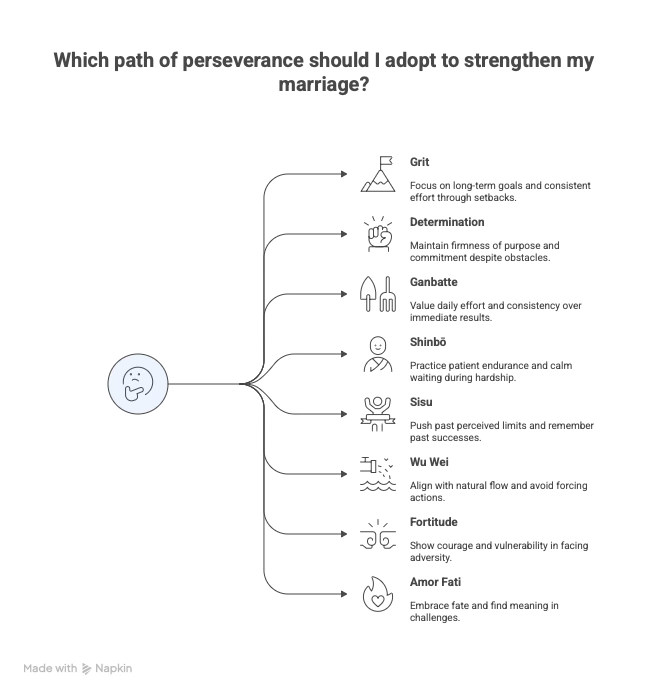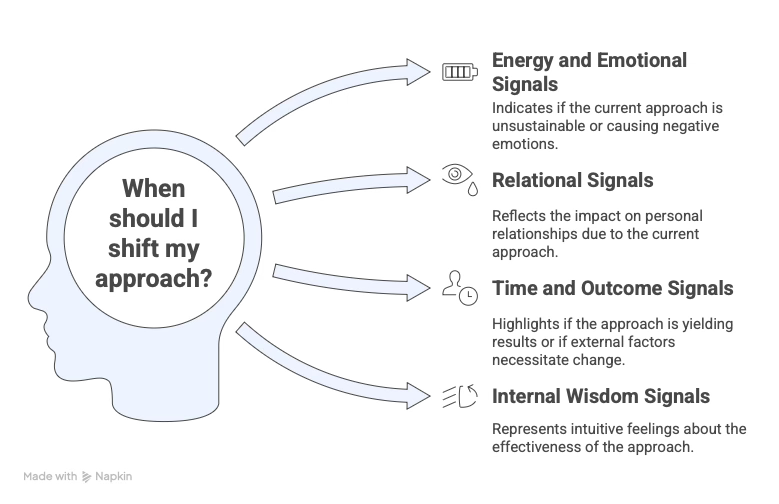Choosing Your Way to Persevere: An Action Menu for When You Feel Like Giving Up

When life gets hard — and when marriage feels impossible — most advice collapses into clichés: “Hang in there.” “Try harder.” “Don’t give up.”
The problem is that these phrases don’t actually tell you how. As in, “how do I hang in there and not give up??”
Perseverance isn’t one-size-fits-all. Sometimes you need to push forward with grit. Sometimes you need patient endurance. Sometimes you need to stop forcing and simply align with the flow. And sometimes you need to reframe the pain as something meaningful, even necessary.
If you can name the type of perseverance you need, you gain clarity. Instead of a vague “keep trying,” you have a word, a lens, a concept to guide your next step. That’s what this article is about: creating an action menu of perseverance mindsets so you can choose the right one when you’re trying to save your marriage… or simply trying to keep going in life.
Why Naming Your Need Matters
Psychologists call it “cognitive framing.” When you give a name to a state of mind, you make it real, definable, and actionable.
Clarity: Instead of flailing in confusion, you know exactly what kind of effort to summon.
Anchored Action: Each concept carries its own prescription: push harder, wait patiently, shift approach, or reframe.
Simplicity in Crisis: When emotions are overwhelming, one word — like fortitude or ganbatte — becomes a compass.
Identity: Saying, “This is a Shinbō moment. I’m practicing patience.” strengthens your sense of agency.
Naming doesn’t just help you think. It helps you act.
Eight Paths of Perseverance
Here are eight cultural and philosophical lenses on perseverance. Each gives a different answer to the question: “What does it mean to keep going right now?”
1. Grit (Western)
Focus: Passion + perseverance toward long-term goals.
How to build it: Clarify your vision, break it into smaller milestones, and keep showing up even through setbacks.
Marriage application: See the marriage itself as a long-term commitment. Your “goal” is restoration, and grit keeps you moving through the long haul. Continue working on yourself, attending counseling, reading books, having difficult conversations… even when progress feels slow.
2. Determination
Focus: Firmness of purpose, regardless of obstacles.
How to build it: Anchor in values, rehearse staying true under pressure, and practice small daily disciplines.
Marriage application: Resolve, “I will not give up on this lightly.” Let that decision steady you when feelings wobble. This isn’t about stubborn persistence at all costs, but about choosing to stay committed to the process of trying — whether that’s individual growth, couples therapy, or difficult conversations.
3. Ganbatte (Japanese)
Focus: Doing your best because the effort itself has dignity.
How to build it: Practice small, daily acts of effort and celebrate consistency more than results.
Marriage application: Every kind gesture, every gentle pause, every patient response matters, even if your spouse doesn’t notice right away. The value isn’t in the outcome; it’s in maintaining your integrity and showing up as your best self, day after day.
4. Shinbō (Japanese)
Focus: Patient endurance, bearing hardship without complaint.
How to build it: Train in waiting calmly (breathing, mindfulness, reframing) and tolerating discomfort.
Marriage application: Endure long seasons of coldness or silence without lashing out. Patience itself becomes your quiet strength. This doesn’t mean accepting abuse or harmful behavior, but rather not escalating conflict when your spouse is processing their own pain.
5. Sisu (Finnish)
Focus: Extraordinary inner strength that appears when you feel spent.
How to build it: Push slightly past your limits in safe contexts and remember past hardships you survived.
Marriage application: When you think you’re done, give one more try, one more apology, one more act of kindness, one more effort at listening. Sisu is the strength that emerges when you’ve reached your perceived limit but choose to take one more step anyway.
6. Wu Wei (Taoist/Chinese)
Focus: Effortless action, aligning with life’s flow instead of forcing.
How to build it: Learn to let go of over-control, look for natural openings, and trust timing.
Marriage application: Stop chasing or forcing talks. Instead, join your spouse in natural opportunities. Like, say, a shared coffee, a walk, a quiet evening. Let connection emerge organically rather than demanding it on your timeline.
7. Fortitude
Focus: Strength and courage in adversity.
How to build it: Reframe pain as meaningful, practice vulnerability, and lean on supportive communities.
Marriage application: Face hard conversations with dignity. Apologize fully. Stay steady when your spouse is upset. Fortitude means having the courage to be vulnerable even when you’re afraid, and finding the strength to do what’s right even when it’s difficult.
8. Amor Fati (Stoic)
Focus: Loving your fate, embracing hardship as necessary and good.
How to build it: Practice gratitude for obstacles and see setbacks as training, not punishment.
Marriage application: Instead of resenting the crisis, accept it as your teacher. Let the difficulty shape you into who you need to be. This doesn’t mean being passive, but rather finding meaning and growth opportunities within the struggle.
How to Choose: The Action Menu
When you’re stuck, start with these reflection questions:
Where am I stuck? Where are we stuck? How can I/we move forward?
Then ask yourself:
Do I need to push forward? → Grit, Determination, Sisu
Do I need to wait it out? → Ganbatte, Shinbō
Do I need to stop forcing and align with flow? → Wu Wei
Do I need to reframe the pain? → Fortitude, Amor Fati
Then choose one word as your anchor for the day:
“This is a Shinbō day — I’ll practice patience.”
“I need Sisu right now — one more step when I feel done.”
“This is a Wu Wei moment — I’ll let connection flow naturally.”
That word becomes your marching orders, turning overwhelm into clarity.
Recognizing When to Shift Approaches
Perseverance (and really, any learning process) is an Action/Reflection/Action cycle. Sometimes what seems clear becomes murky when you take action, and that’s when you need to pivot. Here are signals it might be time to shift your approach:
Energy and Emotional Signals
Your current approach feels forced or depleting rather than sustainable
You notice increasing resentment or bitterness building up
You feel completely stuck, repeating the same ineffective actions
Relational Signals
Your spouse seems to pull away more in response to your efforts
Natural opportunities for connection keep arising, but you’re too agenda-focused to notice them
Conflicts escalate despite your best efforts
Time and Outcome Signals
You’ve been consistent with one approach for a reasonable period without any movement
External circumstances change (job loss, illness, family crisis) and require a different kind of strength
You catch yourself repeatedly saying “this should be working”
Internal Wisdom Signals
You have a gut sense that you’re swimming upstream
You notice you’re more focused on being “right” about your approach than being effective
You feel a quiet inner nudge toward a different way of being
The key is distinguishing between temporary difficulty (where persistence makes sense) versus a signal that your approach itself needs adjusting.
When Perseverance Isn’t the Answer
Here’s what this framework doesn’t say (and I don’t mean): that you should persevere at all costs. Perseverance must be a personal choice, not a shame reaction. There are times when the healthiest response isn’t to keep trying differently, but to recognize that continued effort isn’t serving you or your relationship.
If you’re unsure whether your marriage can be restored or whether continued perseverance is healthy for you, consider using tools like my Core Marriage Mapping Assessment to help evaluate the relationship’s foundation and potential for growth.
The goal isn’t to save every marriage, but to ensure that whatever path you choose, whether that’s continued effort or letting go, comes from a place of intentionality rather than desperation or default.
The Action/Reflection Cycle
Marriage work is inherently experimental. You can’t always know which approach will be most effective until you try it and see how both you and the relationship respond. This means embracing an ongoing cycle:
Reflect: “Where are we stuck? What kind of perseverance might help?”
Act: Choose one approach and commit to it for a reasonable time period
Reflect: “How did that go? What did I learn about myself, my spouse, our dynamic?”
Adjust: Stay with the current approach or shift to a different one
This cycle prevents you from getting locked into ineffective patterns while still giving each approach enough time to work.
Beyond “Just Try Harder”
Most people have a narrow, Western conception of perseverance that’s heavily weighted toward grit and determination, the “push through at all costs” mentality. But sticking to your marriage might actually mean:
Stepping back and waiting (shinbō),
Flowing with natural opportunities rather than forcing them (wu wei),
Finding meaning in the struggle itself (amor fati),
Honoring the dignity of effort regardless of immediate results (ganbatte).
This can be incredibly liberating for people who’ve been beating their head against the wall with one approach. Instead of “I’m failing because I’m not trying hard enough,” it becomes “Maybe I need a different kind of perseverance right now.”
The cultural diversity also matters. It validates that there are multiple ways to approach persistence, rather than one “right” way. Someone whose natural inclination leans toward patient endurance doesn’t have to force themselves into a grit mindset to be “doing it right.”
The Takeaway
Saving a marriage (or surviving a hard season) is rarely about just “trying harder.” It’s about trying differently. Sometimes perseverance means digging deeper (sisu). Sometimes it means staying patient (shinbō). Sometimes it means letting go of control (wu wei).
By naming the kind of perseverance you need, you shift from vague struggle to clear action. And in a marriage crisis, where hopelessness whispers that nothing will change, clarity is the fuel that keeps you going.
The beauty of having multiple approaches is that when one isn’t working, you have seven others to choose from. You’re not stuck with only one tool in your toolkit. You can experiment, adjust, and find the approach that fits both your situation and your authentic way of being in the world.
Remember: The goal isn’t perfect execution of any one approach, but rather the wisdom to know which one your relationship needs right now, and the courage to try it wholeheartedly.
Next step: If you were to name the kind of perseverance you need today, which word would you choose?
Final Note:
If there is one thing I have learned in all of my pursuits, it is that persevering… sticking to it… is the mindset that matters. But it isn’t really enough.
You also need a method of action. Not just a willingness to act, but a way to act. Pushing the wrong way is not a winning strategy.
Persevering the the right way, though, is the path to success.
Having the right information, but not being willing to act, that is one thing. Having the wrong information, but being willing to act, that is one thing.
Having the right information and the willingness to act… THAT is the path to what you want.
While I can’t supply the willingness to act (the point of all the information above), I can provide the information to transform that willingness to success.
👉 Check out my Save The Marriage System by CLICKING HERE. That program helps you shift the underlying issues and problems in your marriage, so that you can save and transform your marriage.
👉 Check out my Save The Marriage Toolkit by CLICKING HERE. These tools are situation-specific to augment your approach from my System… so that you can make more progress when there are other circumstances in your problems.



